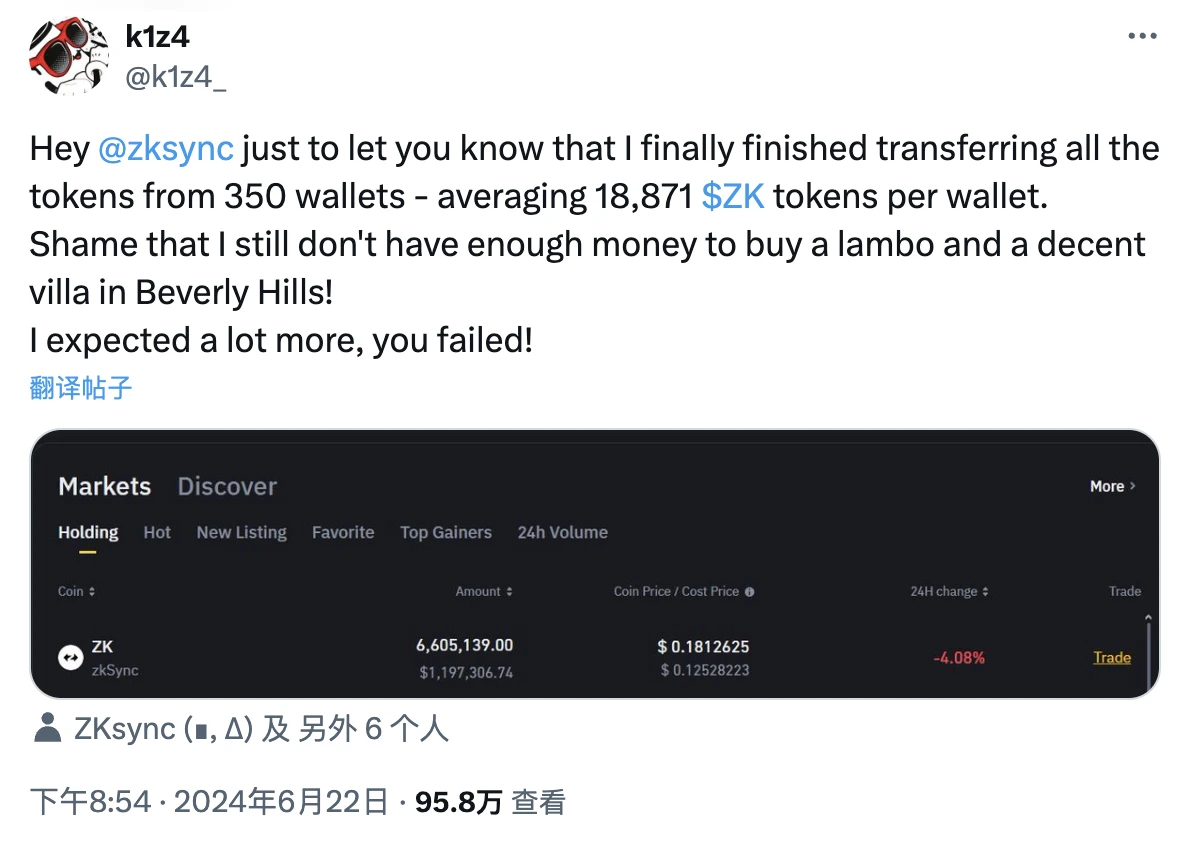Senior Witchs Self-narration: How I Got 6.6 Million ZK Airdrop
Original|Odaily Planet Daily
Author: Azuma
It has been many days since ZKsync (ZK) launched its airdrop, but the aftermath of the incident is still ongoing.
On the evening of June 22, Beijing time, user k1z4 , who was marked as the co-founder of Memeland (his identity has not been verified), posted a rather provocative message: Hey, ZKsync, I want to tell you that I finally completed the airdrop application and transfer of 350 wallets, and each wallet received an average of 18,871 ZK tokens . Unfortunately, I still don’t have enough money to buy a Lamborghini or a Beverly Hills villa… I was looking forward to getting more tokens, you disappoint me so much!
According to the screenshot of holdings on the suspected Binance exchange released by k1z4 , the user eventually obtained a total of 6,605,139 ZKs. Even if calculated based on the falling price of the currency at the time, the value was still as high as nearly 1.2 million US dollars.
After k1z4 showed off publicly, the news quickly spread on CT.
In the early morning of June 23, k1z4 once again posted several updates, roughly explaining his strategy as a senior witch to escape ZKsync witch detection.
First, k1z4 bluntly admitted that he was doing “airdrop farming” , but emphasized that the infrastructure he used to farm 350 wallets was more complex than most Layer2s today, so much so that no one, including ZKsync, could tell the difference between his robot and a real user based on the address behavior – My robot looks more real than most real people.
Specifically, k1z4 revealed that he used 350 IP addresses with independent caches, cookies, RPC, VPN, hosting services, and a series of AI tools , and then spent several days coding the program so that the robot could learn how to interact like a real person based on the various airdrop strategies commonly seen on X.
As a result, it is not only difficult to find the connection between these 350 addresses, but also their interaction behaviors are completely different. k1z4 later revealed that the amount of airdrops received by these addresses also varied, with the lowest being about 9,000 and the highest being 70,000.
However, k1z4 later mentioned that just having technical capabilities is not enough, as such airdrop farming itself requires a lot of financial costs.
k1z4 revealed that in order to smoothly run these 350 robot addresses, he consumed 29.68 ETH in network gas fees alone; it cost an additional US$21,000 to build the robot infrastructure, and he paid 50,000 ZK each to two helpers (who helped detect the operation status of the robots); in addition, he also allocated 200 ETH of funds to allow the robot addresses to flexibly participate in the liquidity pools of major DeFi protocols on the chain.
k1z4 also mentioned that in order to ensure the normal execution of the strategy, he has invested a lot of time and energy in it. These things that cannot be priced are actually costs.
When answering the communitys question Are you doing this for researching new technologies or for money?, k1z4 showed off his values: At first it was just for researching new technologies, but then I found out it could be monetized… you already know the result.
However, although k1z4 finally received airdrop income far exceeding that of ordinary users, he was still not satisfied with this result.
When evaluating the airdrop revenue, k1z4 finally said, “ I am not satisfied with this number. I expect much more than this, but what can you expect from a blockchain that has raised $400 million but still cannot function properly?”
This article is sourced from the internet: Senior Witchs Self-narration: How I Got 6.6 Million ZK Airdrop
Related: dappOS: Building Windows for the Web3 Era
Original author: Biteye core contributor Fishery Original editor: Biteye core contributor Crush In the ever-changing Web3 world of narrative, there is a new way to play every few days, interactions are becoming more and more complex, with more and more steps, and the phishing scams that users face are becoming more and more dangerous. This situation not only raises the entry barrier for new users, but also makes it challenging for experienced users to keep up with the ever-changing pace. In this context, the concept of Intent-Centric came into being, making Web3 interactions more user-friendly and secure. The intention-centric concept allows users to perform complex blockchain operations by defining simple intents without having to worry about the complex technical details behind them. For example, if a user’s intent involves multiple…












